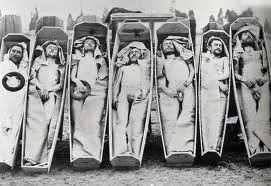Calvino begins his essay, Why read the Classics, by defining
them in terms of a characteristic phrase: “I am re-reading x” The classics are
haunted, as it were, by re-reading. We re-read in the classroom to answer
questions (a site Calvino, I think mistakenly, throws out of consideration – an
awful lot of reading is tied to the classroom, and it often seems that when we
re-read on our own, the ghost of a classroom desk trails behind us, with its
pencil groove and its slight, metallic smell – mixed in my case with the smell
of a brown bag and a peanut butter and jelly sandwich in wax paper ). We
re-read outside of the classroom because, a, we are defensive about not having
read,and want to make it known that we, too, have already read, and b, (the
meat of Calvino’s theme), even when reading the first time, the classic imposes
it scale on us, one that suggests an infinity of re-readings. When reading a
classic, we cannot “escape” its design. In this sense, the classic is the
opposite of escapist literature. We read that to get “lost”, by which we mean
‘lost’ from our everyday routines, our ordinary world, the one outside the
book. It isn’t that we do not get lost in the classics – but it is a different
kind of lost. It is all about disorientation and fate. Freud, in his essay on
the uncanny, tells a story about getting lost in Rome, and finding that, over
and over again, he has taken the wrong roads, which keep leading him back to a
doubtful neighborhood. A neighborhood, we assume, that is a redlight district. Thus,
in one sense, from the perspective of the super-ego Freud is lost, but, from
another, more chthonic perspective, that of the libido, he is following the
line of his fate.
This is the lostness experienced inside the classic. We are
uncomfortably aware of some exterior
intentionality that we have somehow swallowed – we are possessed.
Of course, the classics of high modernism show an acute
awareness of the other kind of lostness. Leopold Bloom is a great admirer of
Paul de Kock, a nineteenth century author of lubricious fare. And the lostness
in the popular novel that is a rush – we read it all at once –is mimicked in
prose that gushes with consciousness – in Ulysses, in To the Lighthouse, in
Sound and the Fury, among others. And yet that enactment of being lost, carried
away, is highly stylized – it is in fact just the kind of thing you don’t find
in a popular novel. These moments are, as well, re-readable – in fact, if there
are degrees in the infinity of re-reading in which the classic lives, they are
even more re-readable than more conventional prose.
Oddly, Calvino misses a trick by confining the notion of
re-reading to the classic text and not comparing it to oral ones – for there
are stories that we tell about ourselves that we seem to tell over and over
again. Years and years ago, I visited Monterray, Mexico, with a friend. I have
found myself telling the story of that visit to dozens of people since. I’m not
sure why that story has stuck with me so much, but as I tell the story, it
becomes more and more devoid of living memory and more and more full of
intentionality – of rhetorical memory, if you will. I have other stories like
that as well. I think most people have a canon of stories they tell about
themselves – their own classics. But in contrast to the re-telling that these
stories seem to compel, there is a certain shyness about telling the same story
twice. We are frankly embarrassed to be caught telling the same story twice. It
is boring. Or it shows some fatal lack of memory – one should remember that X
person has already heard the story.
And this gives us another clue to the nature of classics:
they are eerily unembarrassed. They are not embarrassed about incest, about
patricide and matricide, about dimemberment, and rape, about suicide – all the
stories tumble out. They are even not embarrassed about boredom.
This is what sets the contemporary taste on edge about the
classics. There is nothing more dismissive than the phrase, “that’s boring.” In
a sense, the fear of boredom and the fear of age are connected in the ordinary
norms of our everyday life. Youth sticks in the windpipe of the middle aged,
they can’t cough it up or swallow it. And boredom is especially something to be
fled. In both cases, the organic reality – that we age, and that there are
large necessary patches of boredom in our lives if we actually do anything –
are subject to a repression that expresses itself in the aesthetic sphere – a sphere
that we tend both to diminish (it is only entertainment) and present in social
situations to the exclusion of anything else. In the classics, boredom is intended.
This seems utterly mad to those of us
weaned on the entertainment industry’s quest to never, ever bore. Of course,
that quest is itself mad – it dulls, and it excludes re-reading, which runs
counter to surprise and sensation. The
intentional boredom in the classic doesn’t entail that we will always re-read
the boring patches and be bored – it does entail that the possibility not only
exists, but is embraced. In the Library of Babel, there are an infinite number
of boring texts, and texts that are even more boring, interpreting these boring
texts. A classic that bored completely would not be re-read – one that
interested completely would not be re-read either, for it would tend to impose
the kind of lostness that is foreign to the classic.


